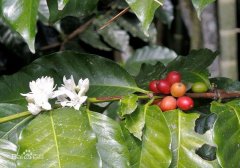Panamanian coffee beans Panamanian Alida boutique coffee beans how much is a jin of coffee beans
The microclimate of the Panamanian highlands is the most important resource that makes Panamanian coffee unique. The most important resource that makes Panamanian coffee unique is its microclimate. Panama's east-west environment allows cold air currents to flow through the Central Mountains and converge above 6500 feet, thus creating a variety of microclimates in the Boquete and Volcán-Candela regions, making them the main producers of Panamanian coffee. These specialty coffees are grown on nutrient-rich, well-balanced soil in the Baru volcano region.
Chinese name Panama Coffee Country Home Panama Phaedra Sex coffee
planting environment
Panama is a small country located in the heart of the American continent. The waters of the Atlantic and Pacific oceans wash over its beaches.
Panama is located at 9 degrees north latitude, at the confluence of the Central Mountain Range, where Mount Baru, one of the highest volcanoes in Central America, is located.
With an elevation of more than 11,400 feet, the surrounding land is rich in nutrients and fertile soil, providing sufficient conditions for the planting and cultivation of Panamanian coffee.
These uplands have the right microclimate, soil, temperature and altitude for the planting, cultivation and harvesting of a wide variety of specialty coffees. These coffees have jasmine, citrus, ripe fruit, berry, caramel, special sweetness, vanilla, chocolate and many other flavors.
Unique coffee.
Panamanian coffee is sorted and numbered in small batches designed to be small in volume for optimal management, and the sorting number allows buyers to understand and track information throughout the process.
Due to its small volume, Panamanian coffee products are based on specialty coffee. The state supplies its high quality products to specialized stores in countries around the world such as Denmark, England, Greece, Norway, Sweden, South Korea, Japan, China Taiwan Province and the United States. The species Geisha was discovered in 1931 in Ethiopia's Guisha Forest and sent to the Coffee Institute in Kenya; introduced to Uganda and Tanzania in 1936, Costa Rica in 1953, Panama in the 1970s by Francesco de la Domba Seven Farm. Mr. Serrazin received seed from CATIE in Costa Rica and began planting rosewood coffee, a hard-won bean because yields were so low and he had to compete.
Important Notice :
前街咖啡 FrontStreet Coffee has moved to new addredd:
FrontStreet Coffee Address: 315,Donghua East Road,GuangZhou
Tel:020 38364473
- Prev

Export quota of Blue Mountain Coffee how to buy Blue Mountain Coffee Raw beans Import Coffee beans
Export quotas according to Jamaica's CIB export statistics as of 2004, 85 per cent of the limited Blue Mountain 1 quota was allocated to Japan, 5 per cent of the United States, 5 per cent of Europe and 5 per cent of other countries. However, in the global consumption distribution of authentic Blue Mountain No. 1, according to the International Coffee Association (ICO), China accounts for 15% of the consumption of Blue Mountain coffee, which stunns the world. The reason is that some universities in Japan and Australia
- Next
Coffee tree species know coffee knowledge
There are more than 6000 species of coffee trees, most of which are tropical trees and shrubs. There are four main coffee trees in the world, of which only two are of real commercial value and are planted in large quantities, and the quality of the coffee beans produced by other coffee trees is also higher than that of other coffee trees. The wild coffee tree is 510 meters high. In artificial cultivation, in order to facilitate picking by hand, it is generally trimmed into
Related
- Guji coffee producing area of Guji, Ethiopia: Humbela, Shakiso, Wulaga
- What is the most expensive variety of Qiloso in BOP multi-variety group?
- How to store the coffee beans bought home?
- Why are Yemeni coffee beans so rare now?
- Ethiopian Sidamo all Red Fruit Sun Sun Santa Vini Coffee beans
- SOE is mostly sour? What does it mean? Is it a single bean? what's the difference between it and Italian blending?
- Is Italian coffee beans suitable for making hand-brewed coffee?
- How to choose coffee beans when making cold coffee? What kind of coffee beans are suitable for making cold coffee?
- Just entered the pit to make coffee, what kind of coffee beans should be chosen?
- Can only Japan buy real Blue Mountain Coffee? What are authentic Jamaican Blue Mountain coffee beans?

